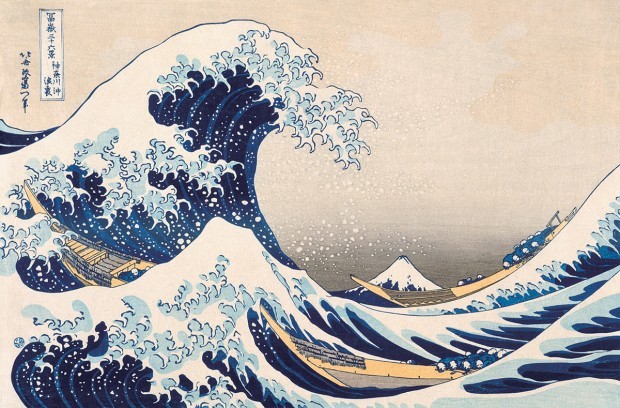Contest between famous masterpieces—how will it end?
A Japanese artist vs. da Vinci, vs. Picasso, vs. Warhol… and the winner is?
This contest was called “The Great Masters of the World vs Hokusai, Famous Masterpieces: The Best of Five Matches.” Other than Vincent van Gogh, the artists shared no common ground on the period of time or location depicted, and no one had any association with 葛飾北斎 (Katsushika Hokusai, 1760-1849) either. Even so, didn’t this comparison of their works make for an interesting “showdown”?
 “Starry Night”, oil painting on canvas 73.7 × 92.1 cm, 1889, Museum of Modern Art, New York. Photo: Granger (PPS News Agency)
“Starry Night”, oil painting on canvas 73.7 × 92.1 cm, 1889, Museum of Modern Art, New York. Photo: Granger (PPS News Agency)
 “The Great Wave off Kanagawa from the Thirty-six Views of Mount Fuji,” oban-sized polychrome woodblock print, after 1831, Edo Period. Photo: Heritage (PPS News Agency)
“The Great Wave off Kanagawa from the Thirty-six Views of Mount Fuji,” oban-sized polychrome woodblock print, after 1831, Edo Period. Photo: Heritage (PPS News Agency)
Vincent van Gogh (1853-1890), born four years after the death of Hokusai, was, as you know, enthralled by 浮世絵 (ukiyo-e) during his stay in Paris (1886-1888) and was an avid collector of woodblock prints. He is well known for having painted works inspired by 歌川広重 (Utagawa Hiroshige’s, 1797-1858) 名所江戸百景 (One Hundred Famous Views of Edo) and other works. But the swirls in the night sky of his “Starry Night” introduced here show signs of having been clearly influenced by the form of Hokusai’s waves in the 「神奈川沖浪裏」 (“The Great Wave off Kanagawa”) from the 「富嶽三十六景」 (Thirty-six Views of Mount Fuji) series.
In a letter to his brother Theo, van Gogh writes,
To Theo van Gogh. Arles, dated Sunday, 23 or Monday, 24 September 18, Amsterdam, Van Gogh Museum.
Although the name Hokusai does not appear here, it is clear that van Gogh’s “man” is Hokusai, and it could be thought that he was speaking about the contents of 『北斎漫画』 (Hokusai Manga).
 “Kendō” (Japanese martial arts), Hokusai Manga Picture Book, 1814, Urakami Collection.
“Kendō” (Japanese martial arts), Hokusai Manga Picture Book, 1814, Urakami Collection.
The elaborate power of description released to depict all aspects of nature, and a sharp, observant eye that supported this skill. There was also another artist in this world who embodied this greatest feature of Hokusai art. This artist was the “versatile genius” Leonardo da Vinci (1452-1519), who burst onto the scene in Italy some three centuries before Hokusai.
 “Mona Lisa,” oil painting on wood panel, 77.0 × 53.0 cm, around 1503-1505, Louvre Museum. Image: Rue des Archives/PPS News Agency
“Mona Lisa,” oil painting on wood panel, 77.0 × 53.0 cm, around 1503-1505, Louvre Museum. Image: Rue des Archives/PPS News Agency
Just as Hokusai burned with the ambition to draw everything in the world, Leonardo da Vinci also had the gift of using his scientific eye to produce with unparalleled accuracy, sketch after sketch of the universe as the vast and elaborate workings of nature, and of history as a flow of time, and by doing so, enclosed these in art. His ultimate masterpiece, “Mona Lisa,” became established as a painting that depicted his ideal universe and history and the mother of all living things. It is interesting to note that this had a commonality with the grand ambition of Hokusai to draw everything in the universe.
When this perspective is taken, an analogy can be seen between Hokusai’s passion and lifelong pursuit of art, and works of art such as Andy Warhol’s (1928-1987) “Marilyn Diptych,” which amplified an image using subject matter and techniques that had not caught the attention of anyone until then; Pablo Picasso’s (1881-1973) “Les Demoiselles d’Avignon,” which first disposed of established styles to recast the shape of things from multiple perspectives in order to build a new world of painting; and even “Untitled (Black Skull),” full of originality born from Jean-Michel Basquiat’s (1960-1988) brimming energy.
Hokusai, by himself, had succeeded in producing works of art in the 19th century that were able to rival each of the masterpieces drawn by these great masters of the world. He was able to freely manipulate the technique, materials, and even the subject matter to draw a universe in a way that no one could—this fact alone should make you appreciate just how exceptional Hokusai’s talent was.












